
Six Day Miracle
From gaining strategic depth in the north and south to taking back the holiest sites in Judaism from Jordanian control, the generals who led the battles describe how this war was won against all odds.
To mark 49 years since the start of the Six Day War on Sunday, the Ministry of Defense released testimonies given by IDF major generals who served in it. Their testimonies were given in the years following the war.
IDF Chief of Staff Lt. Gen. Yitzhak Rabin recalled the time leading up to the Six Day War. “Up until the beginning of May, we were completely convinced that Egypt had made it clear to Syria that the mutual defense contract signed by the two countries in 1966 would only be put into effect if a general war broke out. Our assumption was that if we intiated an attack in Syria it would definitely obligate Egypt (to join), as well.”
These days, the Six day War is considered to have been brought on by an escalation in Israel’s relationship with the Arab world, the relationships between the Arab nations themselves and the intervening of world powers such as the Soviet Union. A new power dynamic was forming in the Middle East, but it was yet unclear as to how Israel should respond to it. “Personally,” said Rabin. “I can’t say that on the eve of the Six Day War I knew what I know now following the war about the Egyptian soldiers' capabilities, particularly when it came to matters of defense. I gave them more credit than was due.”
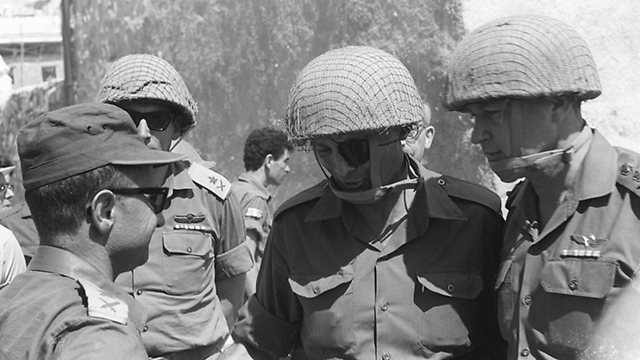
When asked why there was no detailed plan to reclaim the Old City, Rabin disclosed that, in fact, “There was an explicit order not to reclaim the Old City. It was based on political considerations and out of my hands.”
Rabbi Goren refused a ride and ran to the Kotel
Despite Israel warning Jordan not to intervene in the war, Jordan opened fire on Tel Aviv on June 5, took over the Armon Hanatziv neighborhood in Jerusalem, and opened fire on West Jerusalem. On June 7, The IDF’s Jerusalem Brigade and Paratroopers Brigade led by Moti Gur were sent in to take back the Old City. After a grueling battle, the paratroopers, along with artillery forces, arrived at the Lion’s Gate and broke through, fighting their way in until at last they raised the Israeli flag atop the Temple Mount and Western Wall.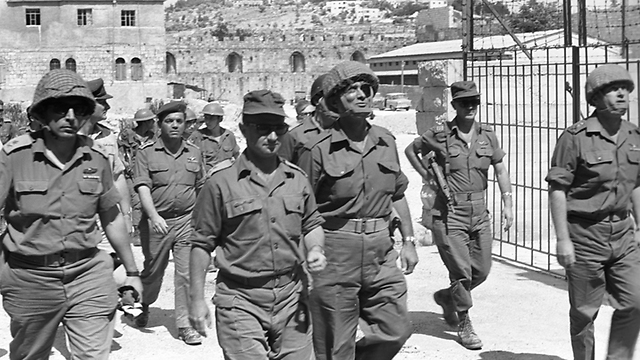
GOC Central Command Maj. Gen. Uzi Narkis verified Rabin’s statements, explaining that it was Prime Minister David Ben-Gurion who clearly distinguished between taking back Jerusalem and the Old City. “There was no order to take the Old City, as Ben-Gurion wanted to avoid any complications.” Narkis added that after the war began, he called Mayor of Jerusalem Theodore “Teddy” Kollek and informed him that “Everything’s fine - you’re going to be the mayor of a united Jerusalem.”
Narkis recalled meeting with Defense Minister Moshe Dayan and trying to convince him to take the Old City. “He flat-out refused, but he looked elated, so I tried again, saying, ‘Moshe, what about the Old City?’ Again he said no. It turned out that at that time the, government still hadn't decided on whether to enter or not.”
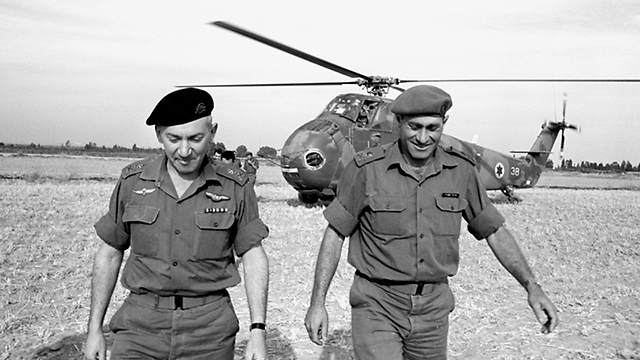
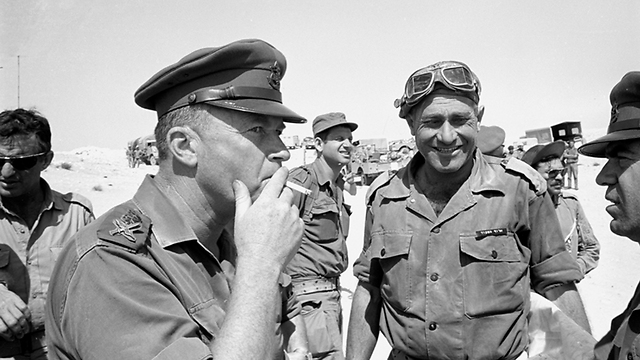
Upon entering the Old City, Narkis ran into the IDF Chief Rabbi Maj. Gen. Shlomo Goren. “I grabbed him and offered him a ride. He refused, and instead ran (to the Old City) with a Torah book in his left hand and a shofar in his right.”
I could have attacked the Temple mount from the air
Air Force Chief Maj. Gen. Mordechai “Mottie” Hod had to decide on a course of action almost by himself. “There was no backup or assistance from any (government) body,” he said. Indeed, later on it revealed that the Air Force’s basic strategic plans were never discussed by the IDF General Staff, but were simply accepted as fact.

Describing the generally flippant attitude in Israel prior to the war, Hod admitted that “Back on May 15, I didn’t take it seriously. I got word about it from the Command Center and said ‘Well, okay.’ I just accepted the head Military Intelligence Directorate’s opinion—which was almost unanimously accepted by all of Israel—that as long as Egyptian President Gamal Nasser was tied up with 90,000 troops in Yemen, he wouldn’t himself get into this war.”
Failing to notify the families of the fallen and injured
Southern Command Maj. Gen. Yeshayahu Gavish elaborated on his role in defending Israel’s border with Sinai. After getting word that the Egyptian army was advancing into Israel, “The IDF General Staff discussed the matter and said that Egypt’s advancement was meant to hinder our capabilities up north. We were to deploy a minimal level (of IDF forces) down south, just to prevent any mishaps. But it wasn’t considered a threat to Israel.” As the person in charge of the southern border, Gavish held a somewhat different attitude of the Egyptian advancement. “I can’t say that I viewed it as an immediate danger, but as I was overseeing that front, I took it more seriously and demanded that more troops be sent.”
Speaking at a conference dedicated to the Six Day war, Gavish voiced criticism over the lengthy amount of time that it took the IDF to inform the families that their loved ones had fallen or were injured. “It lead to a rumor mill, particularly in more remote areas. We made a terrible mistake in not informing the families of the severely injured, who had died by the time their families were given notice.” He admitted that “Waiting around for a week was excruciating, and I consider it as a grave injustice.”
In addition, Gavish criticized the lack of ammunition at Port Said and the fact that the civil defense had built housing that did not include adequate shelter.
Psychological warfare: leaflets on the outposts
Additional documents which were released provide a glimpse into Unit 640, the psychological warfare unit of the IDF. The unit's mission was to erode the enemy's will to fight while assisting IDF forces in newly conquered areas. Using Dassault Mystère jets, the Israel Air
Force air-dropped over 115,000 leaflets onto enemy territory, including 15,000 on Nablus, 10,000 on Jericho, and 10,000 on Gaza.
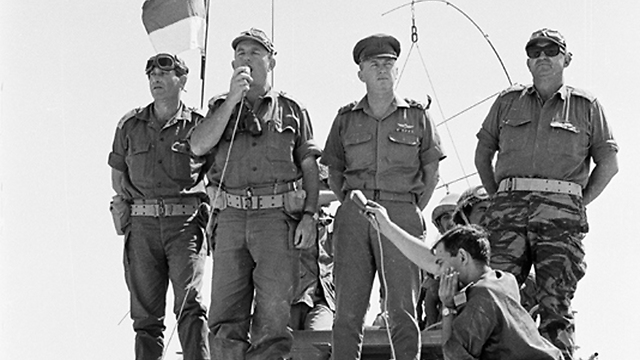
The unit also used powerful loudspeakers to broadcast messages meant to demoralize the enemy forces. The unit only released details of the results of these psychological warfare operations, the results of which sometimes led the enemy to immediately lay down their weapons as opposed to fighting the IDF.
There were several examples of leaflets which were dropped on Jordanian military outposts situated between Ramallah and Nablus. One read "The IDF is coming for you with all of its immense power. The victory of the IDF is certain. We are stronger and more numerous than you. If you stand against us, we will annihilate you. Lay down your weapon so that you might once again see your home. IDF."
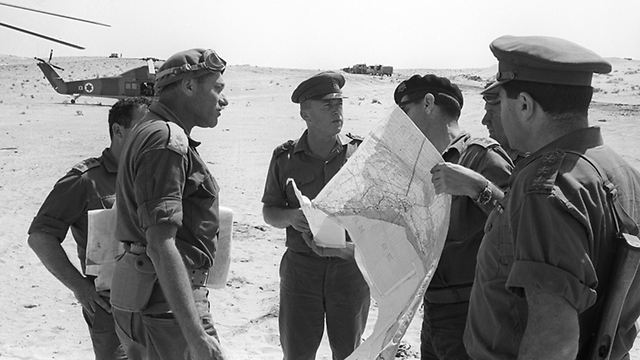
How was this psychological warfare perceived in the eyes of the enemy? An op-ed in the Lebanese military publication "a-Jindi a-Libnani," written a month after the war and translated into Hebrew, states that "the deadliest weapon in the treacherous Israeli enemy's arsenal wasn't napalm bombs or barbaric air raids, nor were they the violent methods (Israel) used against women and children – they were the broadcasts and the rumors they started, the ugly publications they published, their agents, their spies, and their psychological warfare which were designed to sow doubt and fear, to cause despair, and to undermine the foundations of national solidarity."
The op-ed also noted "the (Israeli) attempts to convince (Lebanese forces) that they couldn't win, (attempts) to cause jealousy amongst the officers NGOS and soldiers, undermining confidence in their capacity for leadership and in self confidence, and causing disparagement in the weapons and training (of the armed forces). They caused soldiers to yearn for their children and families by broadcasting disinformation about women who cheated on their husbands."
Hi, there's also a front in the north
The Syrian military had 50,000 troops including huge tank and artillery divisions. They were in control of the Golan Heights and controlled the front. Meanwhile, the IDF only had one brigade and a few other divisions in the area. During the first days of the war, the IDF kept from from fighting the Syrians on the ground so that the Israelis wouldn't have to split their forces between three different fronts.
The Syrian air force was attacked and destroyed however, and a Syrian attempt to capture Tel Dan in northern Israel was repelled. The fighting was primarily done via heavy artillery exchanged for the first three days of the war. It was only when the fighting was beginning to subside on the other fronts that the IDF at last decided to deal with Syria. An entire tank battalion was moved from the West Bank to the front with Syria.
The GOC Northern Command Maj. General David (Dudu) Elazar gave testimony in 1969 regarding the preparations for war.

"All my efforts, at least in this case, was to somehow get the General Staff's attention to the northern front. From the beginning of the escalation, I truely believed that a war with Egypt meant a war with Syria."
General Elazar was not afraid to express his criticism, and was against the plan to occupy Gaza.
"I can tell you that one plan, the plan to occupy the Gaza Strip, makes me hot with anger. I believe it is folly, something which should be forbidden. I have vehemently fought against this plan, and I believe it is a disaster."
However, on June 7th, the Strip was occupied.










